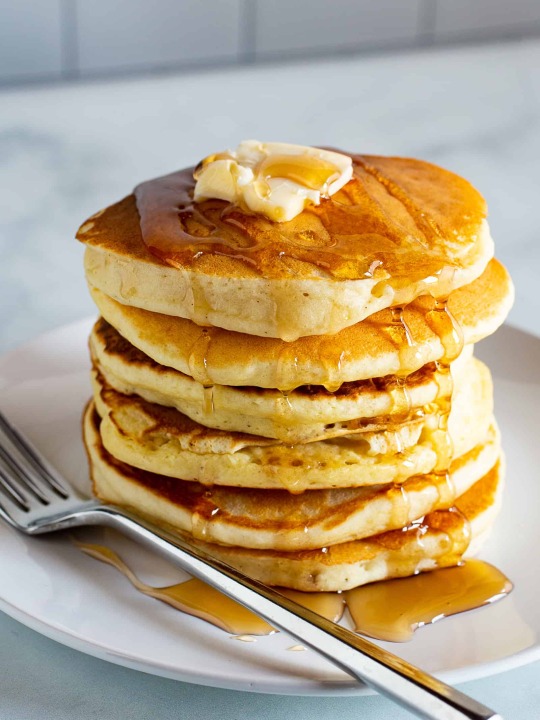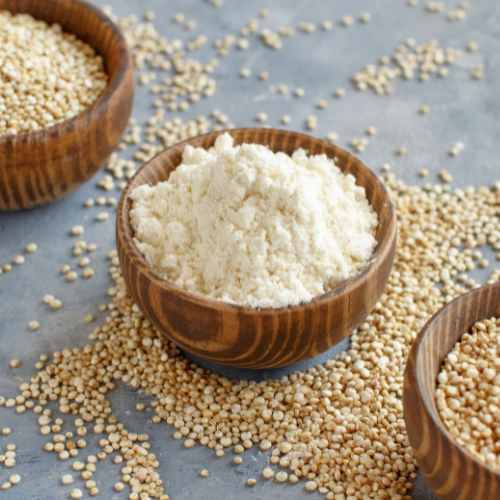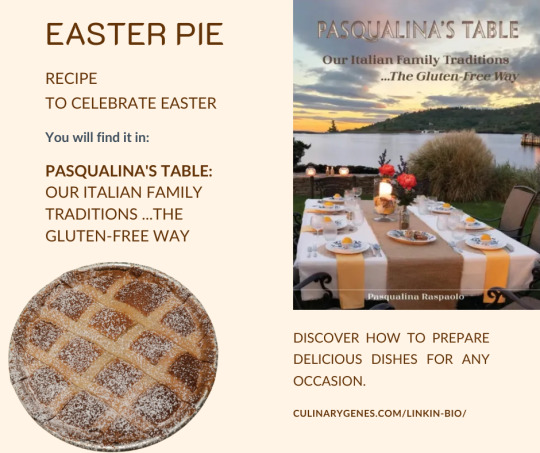#glutenfreebaking
Photo

Fluffy GF Pancakes
324 notes
·
View notes
Text
Why Quinoa Flour is Your New Gluten-Free Go-To

Quinoa flour is a bit of a newcomer but is already proving to be a popular choice amongst those in the know. For those navigating the world of gluten-free cooking, getting to grips with gluten-free flour can sometimes be a daunting task. Packed with all the goodness of quinoa, this flour is a game-changer for those on a gluten-free diet. In this post, we will explore everything you need to know about this fantastic flour alternative. And, for good measure, throw in some tips about how to use it in your favourite recipes.
Introducing Quinoa Flour
Quinoa may be absolutely everywhere but it turns out that it also happens to make a surprisingly good gluten-free flour. Quinoa flour, made from quinoa grain, is rising in popularity due to its excellent nutritional profile and gluten-free credentials. Made by grinding whole quinoa grains into a fine powder, it has a subtle, nutty flavour and can be used as a direct substitute for wheat flour in many recipes. Its versatility makes it an essential ingredient in gluten-free baking, allowing for the creation of delicious, nutrient-dense food items that cater to the needs of gluten-sensitive and health-conscious individuals alike.
Organic quinoa flour
Organic quinoa flour, as the name suggests, is derived from organically grown quinoa grains. This means they are cultivated without the use of synthetic pesticides, or fertilizers, and are non-GMO, ensuring you get the purest form of this nutritious superfood. By choosing organic quinoa flour, you are not only making a healthier choice for your body but also supporting sustainable farming practices that benefit our environment.
Check out our organic quinoa flour
The Nutritional Value of Quinoa Flour
You don't need us to tell you that quinoa is really really good for you, but just in case here's a recap.
Rich in Protein
Quinoa flour stands out in the world of gluten-free alternatives primarily due to its high protein content. Quinoa is in fact made up of 22% protein. Unlike many other actual grains, quinoa is a complete protein, which simply means it contains all nine of the essential amino acids. Pretty exceptional for a plant-based protein! Each serving provides a substantial amount of protein, making it an excellent choice for vegetarians, vegans, or anyone looking to add more plant-based protein to their diet. Unlike traditional grain flours, this high protein content also contributes to the feeling of fullness, making meals more satisfying and aiding in weight management.
This powerful little pseudo-grain is a particularly potent source of the amino acid lysine, which aids in tissue repair.
Vitamins and Minerals
Quinoa flour is not only protein-rich but packed with a variety of essential vitamins and minerals. It contains significant amounts of B vitamins, a wide spectrum of E vitamins, plus a host of minerals including iron, magnesium, potassium, and calcium. A rich source of silica, it can help keep skin strong and elastic. It also has powerful antioxidant properties provided by the E vitamins and flavonoids that appear in high concentrations.
Omega-3 and Fatty acids
Also rich in essential fatty acids, and particularly anti-inflammatory omega-3s, quinoa flour is a rich source of oleic acid which is thought to help lower LDL cholesterol.
Fibre Content
A fantastic source of dietary fibre. Fibre not only keeps everything moving along nicely but also helps to control blood sugar levels by slowing the absorption of sugar into the bloodstream. Plus, high-fibre foods like quinoa flour can help to manage weight by promoting a feeling of fullness and reducing overall calorie intake. So, not only does it provide a gluten-free, protein-packed alternative to traditional flours, but can also contribute to digestive health, blood sugar control, and weight management with its high fibre content.
Gluten-Free
And of course, one of the best things about quinoa is that it is gluten-free.
Is Quinoa Low-Carb?
Quinoa is often thought to be a great choice for those following a low-carb diet. Yet it is important to understand that while quinoa is lower in carbs than some types of grains, it is not strictly a low-carb food. A cup of cooked quinoa contains around 40 grams of carbs, which is more than the daily intake suggested by some low-carb diets. That being said, it's a complex carbohydrate, which means it digests slower than simple carbs and offers sustained energy without causing a rapid spike in blood sugar. Therefore, while not a low-carb food in the strictest sense, it can still be a healthier choice compared to many other grains and is enjoyed by many people following a balanced, healthy diet.
Cooking and Baking with Quinoa Flour
So, while it is good to know just how nutritional this stuff is, what we really want to know is how to cook with it. Right? We will be looking at these things in more detail over time, but here's a quick overview to get you started.
The basics of cooking and baking with quinoa flour
In the realm of gluten-free flour, quinoa flour is high in protein and has a high absorption rate. If you remember from our in-depth guide to using gluten-free flours, these flours can be grouped into two categories. These are protein flours and starches. High protein flours often have more pronounced flavours than starches but they do lend strength and elasticity to a bake. Starches, on the other hand, contribute little in the way of flavour yet they add a fluffy light texture to the heavier protein flours.
Just as some quinoa can be slightly bitter, but not all, the same goes for its flour. Again, the flavour can range from profoundly earthy to pleasingly nutty.
As with most gluten-free flours, this flour is best used alongside other varieties to get the best balance between texture and flavour for your particular recipe needs. That said, your choice of flour will depend very much on what you are making, so there are times when you can directly substitute for all-purpose wheat flour.
Substituting quinoa flour in recipes
Getting to grips with using gluten-free flour is always a bit of a baptism by fire. Recipes and suggestions should be used as a guideline only, largely because such flours can be wholly unpredictable. There is nothing more frustrating than a tried and tested recipe that does not deliver results.
There will be some cases where it is safer to begin with a 1:1 substitution for wheat flour than others. Remember that the protein content makes it denser, and also means it will absorb more water. Gluten is required to build strength, elasticity, and structure into a bake so it is really important in bread making yet can lead to toughness in a pastry. Cakes need little in the way of gluten, yet also require a certain amount of bulk and fluffiness.
And then there is flavour. Quinoa flour has a pronounced flavour. If you find that it tends towards bitterness, then it can be toasted in a moderate oven for about 10 to 15 minutes before cooling and using. So, whilst you may not want to make a delicate Victoria sponge with quinoa flour, it could be perfect for that parmesan pastry you have in mind. Or a more robustly flavoured banana muffin.
So our advice is to begin with a 1:1 ratio in recipes where it may seem appropriate. Like a pastry or a muffin. If you find it too dry, then use a little less flour, or a touch more liquid.
Sauces and batters rely more on the liquid content of the recipe. So substitute your flour slowly, gradually adding more until you reach the desired consistency.
Tips for cooking and baking with quinoa flour
Test small batches first: Before using quinoa flour in large quantities, consider trying it in smaller recipes. This allows you to understand its unique characteristics and adjust your main recipe accordingly.
Blend with other flours: Quinoa flour alone may not suit all recipes. Try blending it with other gluten-free flours to create a balance of flavour and texture.
Adjust liquid levels: Quinoa flour tends to absorb more liquid than wheat flour. Keep an eye on your batter or dough and be prepared to add extra liquid if it seems too dry.
Store properly: Keep your quinoa flour in an airtight container in a cool, dark place. Proper storage preserves the flour's taste and extends its shelf life.
Cooked quinoa flour: If the flavour of quinoa flour is too strong, try toasting it in the oven for 10-15 minutes before cooling and using. This can help to reduce bitterness.
Use in savoury recipes: Quinoa flour can be a wonderful addition to savoury recipes like flatbreads, pizza dough, or pasta, where its unique flavour can shine.
Healthy baking: Use quinoa flour in recipes where health is a priority. It is protein-rich and offers a nutritious alternative to traditional flour.
Quinoa flour in bread-making
It's a whole other subject, but the protein content of quinoa flour makes it an excellent contender in the gluten-free bread stakes. It will need to be used alongside other flours though so we will explore this more fully at a later date.
To sum up, it would certainly seem that even for those without gluten-related disorders, quinoa flour offers a change of pace from traditional flours, allowing for experimentation with diverse, nutrient-rich alternatives in the kitchen.
Have you seen our other gluten-free flours?
This article was reproduced on this site with permission from operafoods.com.au the “Gluten Free Flour Suppliers”.
See original article:- Why Quinoa Flour is Your New Gluten-Free Go-To
Read the full article
2 notes
·
View notes
Text

It's time to shine! Stay tuned and be a part of our remarkable journey.
"LAURICO NUTRACEUTICALS (Coconut-based products)"...
#lauriconutraceuticals#organicproducts#coconutsugar#healthybaking#glutenfreebaking#cleaneating#wholefoods#naturalingredients#plantbasedrecipes#healthyliving#healthyrecipes#organicfood#organicbeauty#coconutoil#coconutwater#organicliving#ecofriendlyproducts#coconutoilbenefits#coconutflour
2 notes
·
View notes
Photo

📍BioCafe Vegan restaurant 🌱 fully loaded waffle with mix fruits, desiccated coconut, chocolate chips, ice cream, whipped cream, drizzled with maple syrup and chocolate sauce, sprinkled with coconut sugar. 🧇🍨🍇🥥🌱 #cosycafevibes #cosycafe #aberdeencafe #breakfast #breakfastgoals #visitABDN #seeninthedeen #eatinthedeen #societyabdn #vegan #raw #paleo #glutenfreebaking #veganbreakfast #colourfulfood #rainbowfood #rainbow #Monday #tumblr #loveyourself #veganaberdeen #aberdeenfood #aberdream #foodblogger #foodofinstagram #instafood #foodcoma @biocafe_aberdeen https://www.instagram.com/p/CjQQ3DgDJwNbgLrRZKmubvrbsj6pRYYkteoAg80/?igshid=NGJjMDIxMWI=
#cosycafevibes#cosycafe#aberdeencafe#breakfast#breakfastgoals#visitabdn#seeninthedeen#eatinthedeen#societyabdn#vegan#raw#paleo#glutenfreebaking#veganbreakfast#colourfulfood#rainbowfood#rainbow#monday#tumblr#loveyourself#veganaberdeen#aberdeenfood#aberdream#foodblogger#foodofinstagram#instafood#foodcoma
2 notes
·
View notes
Photo

Cupcakes with Gluten-Free Pina Colada Filling
Calling all gluten-free dessert lovers. Our Gluten-Free Pina Colada Cupcakes are the perfect way to satisfy your cravings while enjoying a taste of the tropics. Get ready for a burst of pineapple and coconut flavors.
0 notes
Text
Bring the Magic of Easter to Your Table with Pasqualina! 🇮🇹

Easter isn't complete without a slice of tradition, and in Italy, that tradition often comes in the form of a delicious pie!
"Pasqualina's Table: Our Italian Family Traditions…The Gluten-Free Way" isn't just a cookbook, it's a portal to authentic Italian celebrations, straight from our family to yours.
This year, celebrate Easter with the iconic Pastiera di Grano (A pastiera e' gran) - a ricotta and wheat berry pie bursting with flavor and symbolism. Legend has it each ingredient holds a special meaning, a beautiful reminder of the season's significance.
Inside "Pasqualina's Table," you'll find our cherished gluten-free version of this Easter staple. We've kept the tradition alive while ensuring everyone can enjoy a taste of Italy's culinary heritage.
Ready to create unforgettable Easter memories?
Find the link to our cookbook HERE! Share this post with your friends and family who crave a taste of authentic Italian Easter traditions.
We want to hear from you! What are your favorite Easter food traditions? Tell us in the comments below!
#glutenfreepastier#glutenfreepie#easterpie#pastieradigrano#italianeaster#glutenfreeitaliandessert#pasqualinakitchen#glutenfreebaking#glutenfree#easterdessert#recipe#cookbook#italianfood#familyrecipes#traditions#memories#glutenfreeliving#sweets#italianculture#la dolce vita#easterfeast#springvibes#bakinglove#getinmybelly#foodphotography#foodtraditions#celebrateathome
0 notes